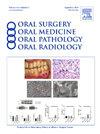单侧小天使:1例报告及文献复习
IF 1.9
3区 医学
Q2 DENTISTRY, ORAL SURGERY & MEDICINE
Oral Surgery Oral Medicine Oral Pathology Oral Radiology
Pub Date : 2025-07-21
DOI:10.1016/j.oooo.2025.04.073
引用次数: 0
摘要
一名8岁的女性在她的儿科牙医的推荐下,向口腔外科医生介绍了她的右后下颌骨的放射性评估。患者的父母未报告患者有明显的病史,且患者既往无手术史。她没有服用任何药物或补充剂。回顾患者的全景x线片显示右下颌骨多室透光,位于未爆发的#31后,并进入上升支。它看起来皮质良好,由几个中等大小的小室组成。它似乎与附近正在发育的31号牙齿分开了。全景x线片的其余部分不明显,与患者年龄相符的出牙模式,17号牙没有明显的牙齿发育或对称的x线片畸变。在体格检查中,口腔外和口腔内软组织无明显变化。未见明显扩张,未见粘膜覆盖。病变的组织病理学特征符合小天使性巨细胞病变。巨细胞病变的颌骨是常见的,但有时需要临床资料,除了组织病理学作出具体的诊断。在本病例中,广泛的嗜酸性血管堵塞和稀疏的出血提示可能的诊断为小天使病。然而,单侧呈现被认为是不寻常的。口腔外科医生联系了病人的家人,他们确认了病人父亲的小天使病史。诊断后,未进行进一步治疗。对小天使症的治疗涉及到警惕的等待,因为青春期通常会阻止疾病的发展。在这种情况下,迄今为止没有进展。文献回顾显示单侧小天使是罕见的。仅报告了4例单侧小天使病,其中2例在持续监测下进展为双侧小天使病。本文章由计算机程序翻译,如有差异,请以英文原文为准。
Unilateral cherubism: a case report and a review of the literature
An 8-year-old female presented to an oral surgeon with a referral from her pediatric dentist for evaluation of a radiolucency of her right posterior mandible. The patient’s parents reported no significant medical history for the patient, and she had no prior surgical history. She was not taking any medications or supplements. Review of the patient’s panoramic radiograph revealed a multilocular radiolucency of the right mandible posterior to an unerupted #31 and into the ascending-ramus. It appeared well-corticated and was composed of a few medium-sized locules. It appeared separate from the nearby developing tooth #31. The remainder of the panoramic radiograph was unremarkable, with appropriate tooth eruption patterns for the patient’s age and no noted tooth development or symmetric radiograph aberration at tooth site #17. On physical examination, the extraoral and intraoral soft tissues were unremarkable. No expansion was obvious and there were no overlying mucosal findings. The histopathologic features of the lesion were consistent with a giant cell lesion of cherubism. Giant cell lesions of the jawbones are common, but at times require clinical information in addition to the histopathology to render a specific diagnosis. In this case, the extensive eosinophilic cuffing of vessels and sparse hemorrhage suggested cherubism as a possible diagnosis. However, the unilateral presentation was considered unusual. The oral surgeon contacted the patient’s family and they were able to confirm a history of cherubism of the patient’s father. After the diagnosis, no further treatment was rendered. Management of cherubism involves watchful waiting as puberty often halts disease progression. In this case, there has been no progression to date. A review of the literature revealed that unilateral cherubism is rare. Only four cases of unilateral cherubism have been reported and of the four, two progressed to bilateral cherubism with continued monitoring.
求助全文
通过发布文献求助,成功后即可免费获取论文全文。
去求助
来源期刊

Oral Surgery Oral Medicine Oral Pathology Oral Radiology
DENTISTRY, ORAL SURGERY & MEDICINE-
CiteScore
3.80
自引率
6.90%
发文量
1217
审稿时长
2-4 weeks
期刊介绍:
Oral Surgery, Oral Medicine, Oral Pathology and Oral Radiology is required reading for anyone in the fields of oral surgery, oral medicine, oral pathology, oral radiology or advanced general practice dentistry. It is the only major dental journal that provides a practical and complete overview of the medical and surgical techniques of dental practice in four areas. Topics covered include such current issues as dental implants, treatment of HIV-infected patients, and evaluation and treatment of TMJ disorders. The official publication for nine societies, the Journal is recommended for initial purchase in the Brandon Hill study, Selected List of Books and Journals for the Small Medical Library.
 求助内容:
求助内容: 应助结果提醒方式:
应助结果提醒方式:


